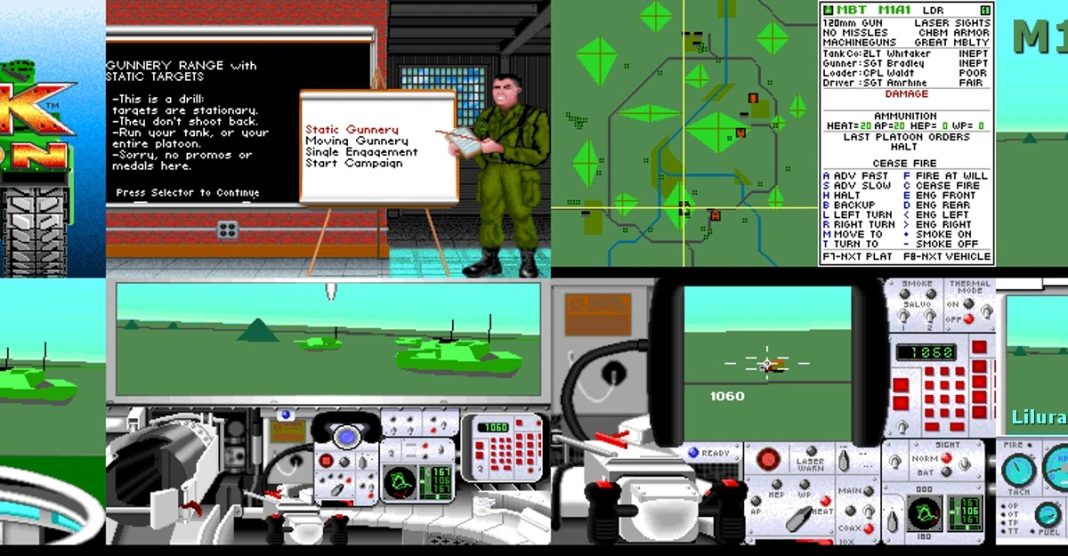I wanted to cover M1 in 1990s Computer Game History, but it misses out by one month. Thus, I will highlight M1 here. This is the 30th computer game from the 1980s that I have reviewed.M1 Tank Platoon was designed by Arnold Hendrick and Scott Spanburg; it was programmed Darrell Dennies and Scott Spanburg.M1 Tank Platoon is a fully real-time 3D tank-sim displayed in 256-color VGA at a resolution of 320×200. The graphics are 3D flat-shaded: terrain, buildings, armored vehicles and aircraft are represented by polygonal models. Explosion effects and smoke plumes are 3D as well, not sprite-based.Due to CPU-speed and RAM-size restrictions in 1989, MPS Labs were not able to represent the heavily-wooded or undulating terrain of the European countryside. Thus, battles take place mostly in wide-open terrain dotted by hills and buildings.M1 could run on as little as 4.77 MHz 8088 or 8086 microprocessors with 384K RAM in 4-color CGA. However, MPS Labs recommended running M1 on i80386 with 640K RAM in 256-color VGA, which resulted in smoother framerates and allowed for increased graphics detail.In assuming the role of an undefined platoon commander, players direct the actions of four M1 Abrams battle tanks in single engagement or full campaign versus Soviet forces in Europe. [1]There are two modes of play that update in real-time and are switched between on-the-fly: simulation mode and strategy mode. Action-sim mode is first- or third-person whereas strategy mode is top-down.Thus, command and control is dual-layered. It was not common for 3D ground vehicle or flight sims of the era to feature dual-layered command and control.Players directly control only one tank in action-sim mode by switching between commander, driver and gunner vantagepoints. However, players can issue commands to the other tanks in the platoon as well as call in artillery and air support (combined arms tactics). [2]As in flight sims and other tank-sims of the era, action-sim mode is switchable between internal first-person views and external tracking views. External tracking views that could be rotated 360 degrees were novel in the late-80s.As it pertains to combat, M1 naturally emphasizes the gunner’s station. When assumed by the player, this is the vantagepoint that can most impact outcomes on battlefields. And it is also the most fun and well-designed aspect of the M1 simulation. At the gunner’s station you can toggle the thermal viewer and switch between 120 mm main gun and the coaxial machine-gun. You can also switch between armor-piercing Sabot and HEAT (High Explosive Anti-Tank) ammunition.M1 also emphasizes defensively positioning tanks behind the crestlines of hills: the turret’s line of sight extends over the crestline while enemy targeting of the tank’s hull is blocked by the crestline (the “hull-down” position).On the other hand, M1 de-emphazies Soviet artillery in comparison to 2D wargames such as Steel Panthers. You are not going to spend hours trying to dig out enemy artillery in M1. Instead, you are contending with the speed, volume and manoeuvrability of Soviet armor.Therefore, M1’s gameplay is fast-paced and exhausting at times; its action-levels akin to the dogfighting flight sims that would become popular in 1990.Top-down strategy mode is a zoomable mapboard that gives an overview of the battlefield in real-time. The mapboard shows various terrain features while highlighting mission objectives and friendly and hostile units (if visible). The mapboard is as well-designed as other aspects of M1; that is, it is pretty much perfect for an action-sim but not on the level of a proper turn-based wargame.Another fun aspect of M1 is starting off with a fledgling tank platoon and promoting its crewmen through six levels of skill to become expert wrecking crews.
